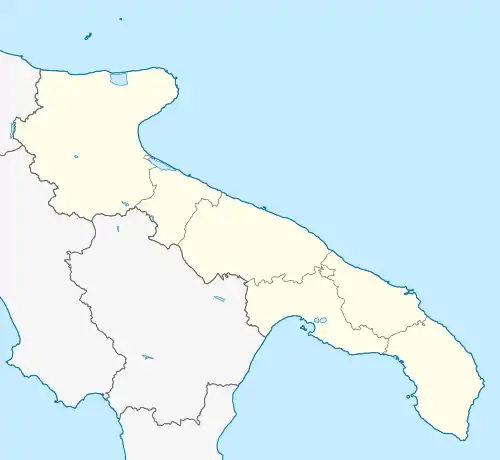San Giorgio Ionico | |
|---|---|
| Comune di San Giorgio Ionico | |
 | |
 Coat of arms | |
Location of San Giorgio Ionico | |
 San Giorgio Ionico Location of San Giorgio Ionico in Italy  San Giorgio Ionico San Giorgio Ionico (Apulia) | |
| Coordinates: 40°27′N 17°22′E / 40.450°N 17.367°E | |
| Country | Italy |
| Region | Apulia |
| Province | Taranto |
| Frazioni | Contrada San Giovanni |
| Government | |
| • Mayor | Cosimo Fabbiano |
| Area | |
| • Total | 23.56 km2 (9.10 sq mi) |
| Elevation | 75 m (246 ft) |
| Population (28 February 2017)[2] | |
| • Total | 15,191 |
| • Density | 640/km2 (1,700/sq mi) |
| Demonym | Sangiorgesi |
| Time zone | UTC+1 (CET) |
| • Summer (DST) | UTC+2 (CEST) |
| Postal code | 74027 |
| Dialing code | 099 |
| Patron saint | San Giorgio |
| Saint day | 23 April |
| Website | Official website |
San Giorgio Ionico is a town and comune in the province of Taranto, in the northern Salento, part of the Apulia region of southeast Italy. San Giorgio Ionico was historically an Arbëreshë settlement. After the inhabitants abandoned the Albanian Greek Orthodox faith they assimilated into the local population.[3]
History
Human settlements in the area date to as early as the 3rd century BC, as shown by the findings of remains of Iron Age, Hellenistic and Roman structures, and a 4th–3rd century BC necropolis.
The town itself developed starting from the 10th century AD, when refugees from Taranto, then being under the Saracen assault, established near the current Chiesa Madre (Mother Church). New migrants came in the 15th century after the arrival of the Albanian leader Skanderbeg. The town is first mentioned, however, only in 1522.
Population increased in the 1970s when, aside from the traditional agricultural economy, the services and industrial sectors started to expand.
References
- ↑ "Superficie di Comuni Province e Regioni italiane al 9 ottobre 2011". Italian National Institute of Statistics. Retrieved 16 March 2019.
- ↑ Population from ISTAT
- ↑ P. Bruni, ed. (2004). Arbëreshë: cultura e civiltà di un popolo. p. 33. ISBN 9788824020091.